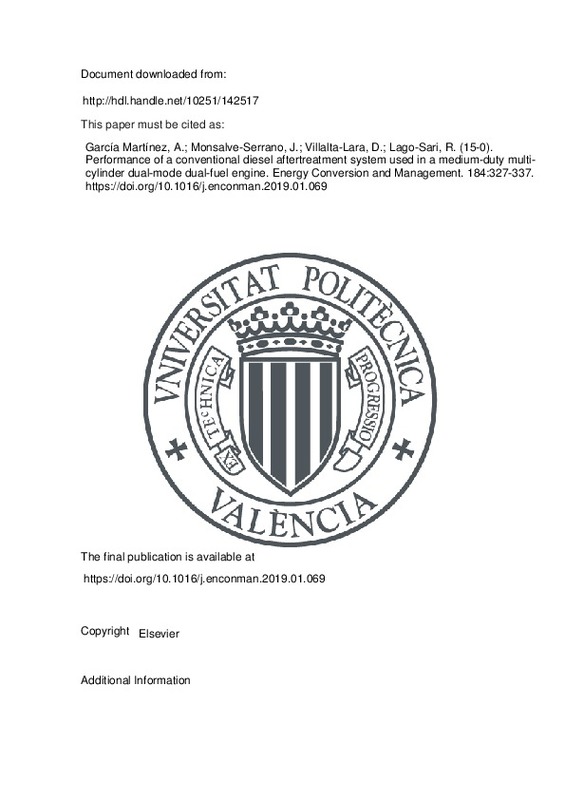JavaScript is disabled for your browser. Some features of this site may not work without it.
Buscar en RiuNet
Listar
Mi cuenta
Estadísticas
Ayuda RiuNet
Admin. UPV
Performance of a conventional diesel aftertreatment system used in a medium-duty multi-cylinder dual-mode dual-fuel engine
Mostrar el registro sencillo del ítem
Ficheros en el ítem
| dc.contributor.author | García Martínez, Antonio
|
es_ES |
| dc.contributor.author | Monsalve-Serrano, Javier
|
es_ES |
| dc.contributor.author | Villalta-Lara, David
|
es_ES |
| dc.contributor.author | Lago-Sari, Rafael
|
es_ES |
| dc.date.accessioned | 2020-05-06T07:18:03Z | |
| dc.date.available | 2020-05-06T07:18:03Z | |
| dc.date.issued | 2019-03-15 | es_ES |
| dc.identifier.issn | 0196-8904 | es_ES |
| dc.identifier.uri | http://hdl.handle.net/10251/142517 | |
| dc.description.abstract | [EN] Dual-mode dual-fuel combustion stands as one of the promising techniques to allow the dual-fuel operation along the whole engine map. This concept relies on using different combustion strategies as reactivity controlled compression ignition up to medium load, then migrating to diffusive dual-fuel combustion to reach full load. With this strategy, it is possible to obtain sensible reductions in NOx and soot while providing improvements in fuel consumption and CO2 emissions. However, the excessive quantities of HC and CO together with the low exhaust temperature can compromise the diesel oxidation catalyst (DOC) efficiency. In addition, the diffusive dual-fuel combustion applied at high engine load produces considerable soot amounts that should be reduced within the diesel particulate filter (DPF). Based on these facts, this work intends to evaluate the efficiency of a commercial aftertreatment system (DOC¿+¿DPF) while operating in dual-mode dual-fuel combustion. Additionally, fundamental studies where developed to understand the impact of the combination of fuels on the exhaust hydrocarbon species. First, the DOC performance was evaluated at steady-state and transient conditions under different operating conditions fulfilling the EUVI NOx and soot limits. In parallel, the different engine-out hydrocarbon species were measured by means of a Fourier-transform infrared spectroscopy (FTIR) gas analyzer. Finally, the passive and active regeneration processes were assessed by means of different methodologies aiming to evaluate the low NOx-low soot interaction and the capability of the active regeneration in dual-fuel dual-mode (DMDF) operating conditions. The DOC results showed an improper conversion efficiency at low load operating condition, where the exhaust temperature is low. By contrast, the thermal inertia at transient conditions allowed to improve the DOC behavior at low load, reaching DOC-out emissions one order of magnitude lower than those from the steady-state tests. Concerning the DPF, it was demonstrated that the low concentration of NOx and soot produced during the combustion does not lead to sensible changes in the NO2/NOx ratio before and after the DPF, indicating a low level/absence of passive regeneration. In the case of the active regeneration, both conventional diesel combustion (CDC) and DMDF operating conditions can obtain satisfactory reduction in the total soot trapped, being the increase in the exhaust temperature consequence of the HC and CO conversion the supporting mechanism for the active regeneration in the DMDF concept. | es_ES |
| dc.description.sponsorship | The authors thanks VOLVO Group Trucks Technology and ARAMCO Overseas Company for supporting this research. The authors also acknowledge FEDER and Spanish Ministerio de Economía y Competitividad for partially supporting this research through TRANCO project (TRA2017-87694-R). | es_ES |
| dc.language | Inglés | es_ES |
| dc.publisher | Elsevier | es_ES |
| dc.relation.ispartof | Energy Conversion and Management | es_ES |
| dc.rights | Reserva de todos los derechos | es_ES |
| dc.subject | Dual fuel combustion | es_ES |
| dc.subject | Aftertreatment | es_ES |
| dc.subject | Emissions | es_ES |
| dc.subject | Catalyst | es_ES |
| dc.subject | Speciation | es_ES |
| dc.subject | Particulate filter | es_ES |
| dc.subject.classification | MAQUINAS Y MOTORES TERMICOS | es_ES |
| dc.title | Performance of a conventional diesel aftertreatment system used in a medium-duty multi-cylinder dual-mode dual-fuel engine | es_ES |
| dc.type | Artículo | es_ES |
| dc.identifier.doi | 10.1016/j.enconman.2019.01.069 | es_ES |
| dc.relation.projectID | info:eu-repo/grantAgreement/AEI/Plan Estatal de Investigación Científica y Técnica y de Innovación 2013-2016/TRA2017-87694-R/ES/REDUCCION DE CO2 EN EL TRANSPORTE MEDIANTE LA INYECCION DIRECTA DUAL-FUEL DE BIOCOMBUSTIBLES DE SEGUNDA GENERACION/ | es_ES |
| dc.rights.accessRights | Abierto | es_ES |
| dc.contributor.affiliation | Universitat Politècnica de València. Departamento de Máquinas y Motores Térmicos - Departament de Màquines i Motors Tèrmics | es_ES |
| dc.description.bibliographicCitation | García Martínez, A.; Monsalve-Serrano, J.; Villalta-Lara, D.; Lago-Sari, R. (2019). Performance of a conventional diesel aftertreatment system used in a medium-duty multi-cylinder dual-mode dual-fuel engine. Energy Conversion and Management. 184:327-337. https://doi.org/10.1016/j.enconman.2019.01.069 | es_ES |
| dc.description.accrualMethod | S | es_ES |
| dc.relation.publisherversion | https://doi.org/10.1016/j.enconman.2019.01.069 | es_ES |
| dc.description.upvformatpinicio | 327 | es_ES |
| dc.description.upvformatpfin | 337 | es_ES |
| dc.type.version | info:eu-repo/semantics/publishedVersion | es_ES |
| dc.description.volume | 184 | es_ES |
| dc.relation.pasarela | S\377337 | es_ES |
| dc.contributor.funder | Saudi Aramco | es_ES |
| dc.contributor.funder | Agencia Estatal de Investigación | es_ES |
| dc.contributor.funder | European Regional Development Fund | es_ES |
| dc.contributor.funder | Volvo Research and Educational Foundations, Suecia | es_ES |







![[Cerrado]](/themes/UPV/images/candado.png)

